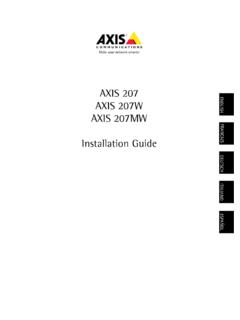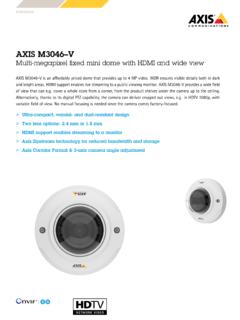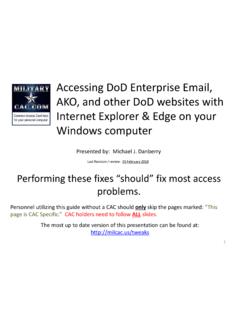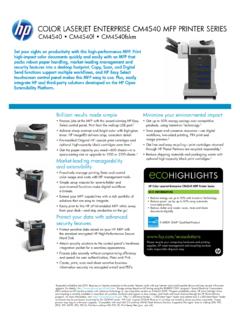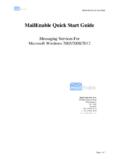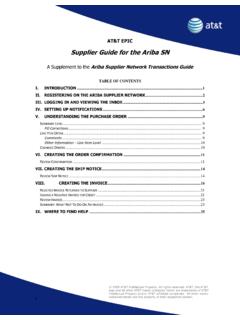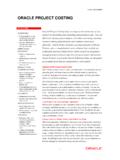Transcription of Hardening Guide - Axis Communications
1 Hardening Guide Cameras Table of contents1. Introduction Security cameras in a network environment Limit Internet exposure Limit local network exposure 32. About the protection levels 43. Default protection 44. Standard protection Factory default settings Use latest firmware Set master password Create a video client account Configure network settings Set time and date Disable audio Edge Storage Encryption 65. enterprise protection Open ports HTTP digest authentication Domain and host name Disable unused services FTP server SSH Secure Shell ARP/Ping setting of IP address axis Device Dispatcher AVHS Network discovery protocols SOCKS Always multicast video QoS - Quality Of Service IP address filter (IP tables) HTTPS Encryption 106.
2 Managed enterprise protection IEEE network access control SNMP monitoring Remote System Log 11 About this document 12 Contact information 13 Suppor t 1331. IntroductionAxis strives to apply cybersecurity best practices in the design, development and testing of our devices to minimize the risk of flaws that could be exploited in an attack. However, securing a network, its devices, and the services it supports requires active participation by the entire vendor supply chain, as well as the end-user organization.
3 A secure environment depends on its users, processes, and technology. Therefore, we created this Guide to support you in securing your network, devices and services. The Guide provides technical advice for anyone involved in deploying axis video solutions. It establishes a baseline configuration as well as a Hardening Guide that deals with the evolving threat landscape. Like that of many other security organizations, the axis baseline uses the CIS Controls - Version , see These controls were previously known as SANS Top 20 Critical Security Controls. This document refers to these CSC (Critical Security Control) by marking CSC#.
4 You may need the product s User Manual to learn how to configure specific settings. axis provides ACM ( axis Camera Management) free of charge that helps manage a number of security controls more : This document, contact information and security advisories can be found at Security cameras in a network environmentThe most apparent threats to a network camera are physical sabotage, vandalism and tampering. To protect the product from these threats, it is important to select a vandal-resistant model or casing, to mount it in the recommended way, and to protect the an IT/network perspective, the camera is a network endpoint similar to business laptops, desktops and mobile devices.
5 Unlike a business laptop, a network camera is not exposed to the common threat of users visiting potentially harmful websites, opening malicious email attachments, or installing untrusted applications. However, the camera is a network device with an interface that may expose the system to risks. This Guide focuses on reducing the exposure area of these Limit Internet exposureIt is not recommended to expose the camera as a public web server, allowing unknown clients to get network access to the camera. For Individuals and small organizations that do not operate a VMS (Video Management System) and need to access video from remote locations, axis recommends using axis Companion.
6 axis Companion is a Windows/IOS/Android client software, free of charge, that pro-vides an easy way to access video in a more secure way without exposing the camera to the Internet. Information and download for axis Companion can be found at Large or-ganizations using a VMS should consult the VMS vendor for remote video access. Limit local network exposureIn a VMS environment, the clients will always access live and recorded video through the VMS server. Placing the VMS server and cameras on an isolated network, through physical or virtual isolation, is a common and recommended measure to reduce exposure and risks.
7 42. About the protection levelsThis Guide uses different protection levels depending on system size and needs. Each level assumes that the previous level s recommendations are levelRecommended forProcedures0 Default protectionOnly recommended for demo purposes and test protectionMinimum recommended level of protection. This level is adequate for small businesses or office installations where, typically, the operator is also the administrator. >Factory default settings >Use latest firmware >Set the master password >Create a video client account >Configure network settings >Set time and date >Disable audio when applicable >Edge Storage Encryption2 enterprise protectionRecommended settings for corporations that have a dedicated system administrator.
8 >HTTP digest authentication >Domain and host name >Disable unused services >IP Address filter >HTTPS Encryption3 Managed enterprise protectionLarge network infrastructure with an IT/IS department. For environments where cameras may need to be integrated into an enterprise network infrastructure. >IEEE Network Access Control >SNMP monitoring >Remote system log3. Default protectionCameras are delivered with predefined default settings and a default password. It is not recommended to use these settings for daily operations. 54. Standard protectionThe standard protection level is the minimum recommended level of protection.
9 This level is adequate for small businesses and small organizations where, typically, the operator is also the Factory default settingsCSC #3: Secure configuration for hardware and starting, make sure that the product is in a known factory default state. If you are unsure of the state, go to System Options > Maintenance and click Use latest firmwareCSC #2: Inventory of authorized and unauthorized new vulnerabilities are discovered, most are either not critical or are very costly to exploit. Occasionally a critical vulnerability is discovered, and device, computer, and systems services need to be patched.
10 Patching software and firmware is an important process of cybersecurity. An attacker will often try to exploit common (known) vulnerabilities, and if they gain network access to an unpatched service, they may succeed. Make sure you always use the latest firmware because it may include security patches for known vulnerabilities. The release notes for a specific firmware may explicitly mention a critical security fix but not all the general the latest firmware file to your computer. The latest version is always available free of charge at Before upgrading the firmware, read the instructions in the User Set master passwordCSC #5: Controlled use of administrative password is the most important means of protection for a network camera.





